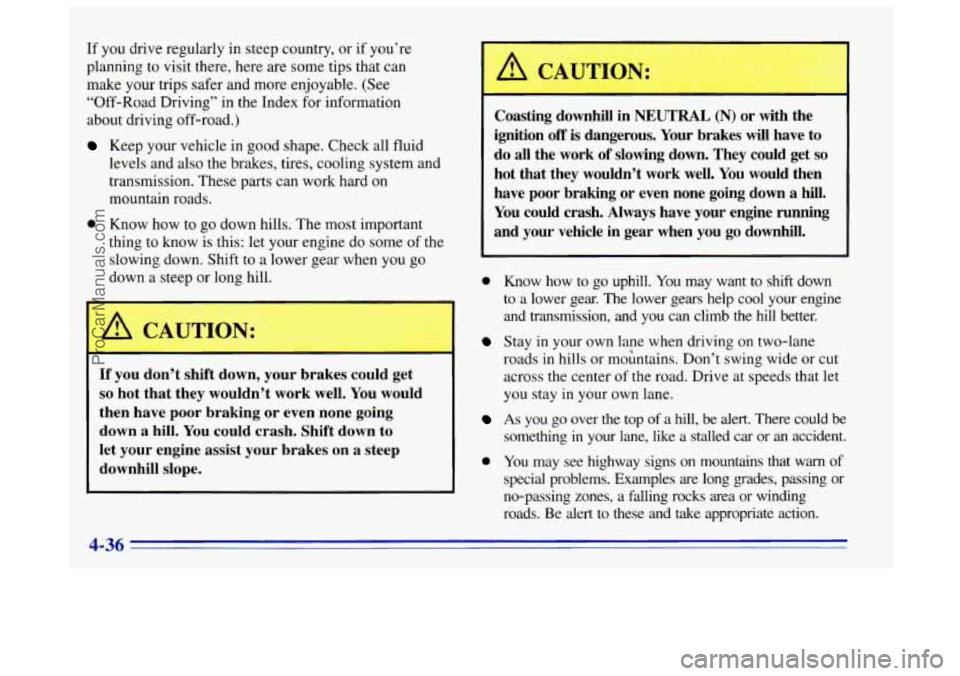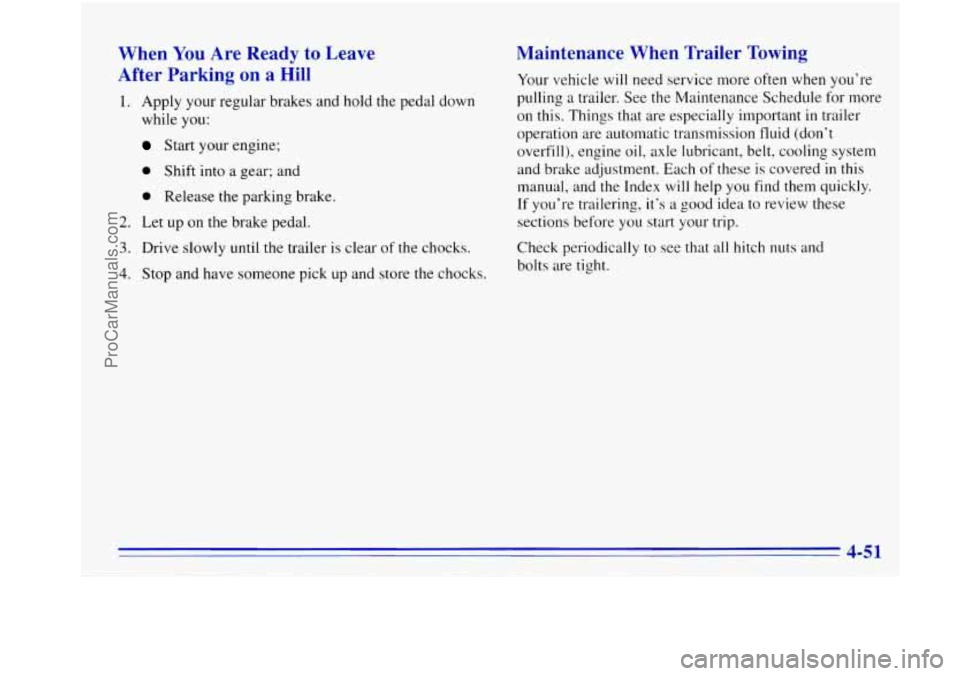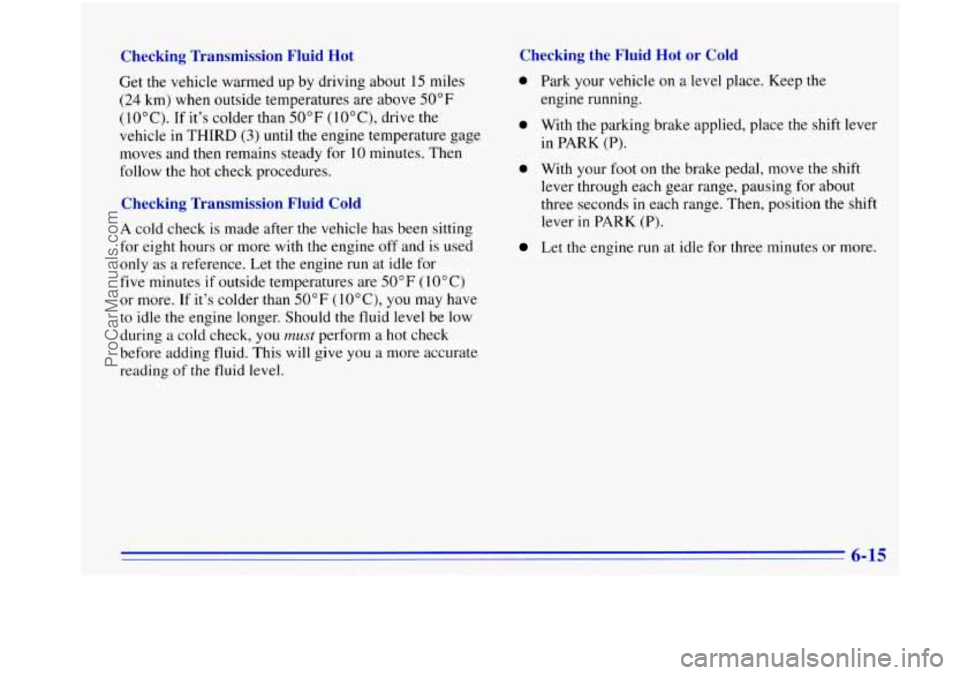check transmission fluid OLDSMOBILE BRAVADA 1996 Owners Manual
[x] Cancel search | Manufacturer: OLDSMOBILE, Model Year: 1996, Model line: BRAVADA, Model: OLDSMOBILE BRAVADA 1996Pages: 340, PDF Size: 17.49 MB
Page 164 of 340

If you drive regularly in steep country, or if you’re
planning to visit there, here are some tips that can
make your trips safer and more enjoyable. (See
“Off-Road Driving” in the Index for information
about driving off-road.)
Keep your vehicle in good shape. Check all fluid
levels and also
the brakes, tires, cooling system and
transmission. These parts can work hard
on
mountain roads.
0 Know how to go down hills. The most important
thing to know is this: let your engine do some
of the
slowing down. Shift to a lower gear when you go
down a steep or long hill.
I A CAUTION:
I
If you don’t shift down, your brakes could get
so hot that they wouldn’t work well. You would
then have poor braking or even none going
down
a hill. You could crash. Shift down to
let your engine assist your brakes on
a steep
downhill slope.
fi CAUTION:
Coasting downhill in NEU (N) or with the
ignition
off is dangerous. Your brakes will have to
do all the work
of slowing down. They could get so
hot that they wouldn’t work well. You would then
have poor braking or even none going down
a hill.
You could crash. Always have your engine running
and your vehicle in gear when you go downhill.
0 Know how to go uphill. You may want to shift down
to
a lower gear. The lower gears help cool your engine
and transmission, and you can climb the hill better.
Stay in your own lane when driving on two-lane
roads
in hills or mountains. Don’t swing wide or cut
across the center
of the road. Drive at speeds that let
you stay
in your own lane.
As you go over the top of a hill, be alert. There could be
something
in your lane, like a stalled car or an accident.
0 You may see highway signs on mountains that warn of
special problems. Examples are long grades, passing or
no-passing zones, a falling rocks area
or winding
roads. Be alert
to these and take appropriate action.
ProCarManuals.com
Page 179 of 340

When You Are Ready to Leave
After Parking on a Hill
1. Apply your regular brakes and hold the pedal down
while you:
Start your engine;
0 Shift into a gear; and
0 Release the parking brake.
2. Let up on the brake pedal.
3. Drive slowly until the trailer is clear of the chocks.
4. Stop and have someone pick up and store the chocks.
Maintenance When Trailer Towing
Your vehicle will need service more often when you’re
pulling a trailer. See the Maintenance Schedule for more
on this. Things that are especially important
in trailer
operation are automatic transmission fluid (don’t
overfill), engine
oil, axle lubricant, belt, cooling system
and brake adjustment. Each
of these is covered in this
manual, and the Index
will help you find them quickly.
If you’re trailering, it’s a good idea to review these
sections before you start your trip.
Check periodically to
see that all hitch nuts and
bolts are tight.
ProCarManuals.com
Page 226 of 340

Automatic Transmission Fluid
When to Check and Change
A good time to check your automatic transmission fluid
level is when the engine oil is changed.
Change both the fluid and filter every
50,000 miles
(83 000 km) if the vehicle is mainly driven under one or
more
of these conditions:
In heavy city traffic where the outside temperature
regularly reaches
90°F (32°C) or higher.
In hilly or mountainous terrain.
0 When doing frequent trailer towing.
Uses such as found in taxi, police or delivery service.
If you do not use your vehicle under any of these
conditions,
the fluid and filter do not require changing.
See “Scheduled Maintenance Services” in the Index.
How to Check
Because this operation can be a little difficult, you may
choose to have this done at your Oldsmobile retail
facility Service Department.
If you do it yourself, be sure to follow all the instructions
here, or you could get a false reading on the dipstick.
I NOTICE:
- ~~
Too much or too little fluid can damage your
transmission.
Too much can mean that some of
the fluid could come out and fall on hot engine
parts
or exhaust system parts, starting a fire. Be
sure to get an accurate reading if you check your
transmission fluid.
Wait at least 30 minutes before checking the
transmission fluid level
if you have been driving:
0 When outside temperatures are above 90°F (32°C).
0 At high speed for quite a while.
0 In heavy traffic -- especially in hot weather.
0 While pulling a trailer.
To get the right reading, the fluid should be at normal
operating temperature, which
is 180°F to 200°F
(82°C to
93°C).
ProCarManuals.com
Page 227 of 340

Checking Transmission Fluid Hot
Get the vehicle warmed up by driving about 15 miles
(24 km) when outside temperatures are above 50°F
(10°C). If it's colder than 50°F (lO"C), drive the
vehicle in THIRD
(3) until the engine temperature gage
moves and then remains steady for
10 minutes. Then
follow the hot check procedures.
Checking Transmission Fluid Cold
A cold check is made after the vehicle has been sitting
for eight hours or more with the engine off and
is used
only
as a reference. Let the engine run at idle for
five minutes
if outside temperatures are 50°F (10°C)
or more. If it's colder than 50°F (lO"C), you may have
to idle the engine longer. Should the fluid level be low
during a cold check, you must perform a hot check
before adding fluid. This will give
you a more accurate
reading of
the fluid level.
Checking the Fluid Hot or Cold
0 Park your vehicle on a level place. Keep the
engine running.
0 With the parking brake applied, place the shift lever
in PARK
(P).
0 With your foot on the brake pedal, move the shift
lever through each gear range, pausing for about
three seconds
in each range. Then, position the shift
lever
in PARK (P).
Let the engine run at idle for three minutes or more.
ProCarManuals.com
Page 229 of 340

How to Add Fluid All-Wheel Drive
Refer to the Maintenance Schedule to determine what
kind
of transmission fluid to use. See “Recommended
Fluids and Lubricants”
in the Index.
Add fluid only after checking the transmission fluid
HOT. (A COLD check is used only as a reference.) If
the fluid level is low, add only enough of the proper
fluid
to bring the level up to the HOT area for a hot
check.
It doesn’t take much fluid, generally less than a
pint
(0.5 L). Don’t overfill. We recommend you use only
fluid labeled DEXRON@-111, because fluid with that
label is made especially for your automatic transmission.
Damage caused by fluid other than DEXRON-I11 is not
covered by your new vehicle warranty.
Transfer Case
When to Check Lubricant
Refer to the Maintenance Schedule to determine how
often
to check the lubricant. See “Periodic Maintenance
Inspections“
in the Index.
How to Check Lubricant
After adding fluid, recheck the fluid level as
described under
“How to Check.”
When the correct fluid level is obtained, push the
dipstick back in all the way; then flip the handle
down
to lock the dipstick in place.
If the level is below the bottom of the filler plug hole,
you’ll need
to add some lubricant. Add enough lubricant
to raise the level to the bottom of the filler plug hole.
6-17
.~ --
ProCarManuals.com
Page 270 of 340

Capacities (Approximate)
Cooling System* ............. 11.7 quarts (1 1.1 L)
Crankcase with Filter* .......... 4.5 quarts (4.3 L)
Automatic Transmission
(Drain and Refill)*
........... 5.0 quarts (4.7 L)
Differential Fluid (Rear) ......... 4.0 pints ( 1.9 L)
Differential Fluid (Front) ......... 2.6 pints (1.2 L)
Fuel Tank ..................... 18 gallons (68 L)
A/C Refrigerant ........ 30 oz. or 2 lbs. (0.9 kg) of
R- 134a
*After refill, the level
must be checked.
A- I Co:~ ~ Jitioning Refrigerants
not all air conditioning refrigerants are the same.
If the air conditioning system in your vehicle needs
refrigerant, be sure the proper refrigerant is used.
If you’re
not sure, ask your Oldsmobile retailer.
Vehicle Dimensions*
Wheelbase .............. 107.0 inches (271.8 cm)
Length
................. 180.9 inches (459.5 cm)
Height ................... 63.2 inches (160.5 cm)
Width ................... 67.6 inches (17 1.7 cm)
Front Tread
............... 57.3 inches (145.4 cm)
Rear Tread
............... 55.1 inches (139.9 cm)
*Figures reflect base equipment
only.
ProCarManuals.com
Page 286 of 340

I Short TripKity Maintenance Schedule I
48,000 Miles (80 000 km)
0 Change engine oil and filter (or every
3 months, whichever occurs first).
An Emission Control Service.
0 Lubricate chassis components; see
footnote
# (or every 3 months,
whichever occurs first).
0 Check readfront axle fluid level and add
fluid as needed. Check constant velocity
joints and axle seals for leaking.
**
DATE ACTUAL MILEAGE SERVICED BY
50,000 Miles (83 000 km)
0 Change automatic transmission fluid and
filter
if the vehicle is mainly driven under
one
or more of these conditions:
- In heavy city traffic where the outside
temperature regularly reaches
90°F
(32°C) or higher.
- In hilly or mountainous terrain.
- When doing frequent trailer towing.
- Uses such as found in taxi, police or
If you do not use your vehicle under any of
these conditions, the fluid and filter do not
delivery service.
require changing.
DATE ACTUAL MILEAGE SERVICED BY
7-16
ProCarManuals.com
Page 302 of 340

I
Long Tripmighway Maintenance Schedule
45,000 Miles (75 000 km)
0 Change engine oil and filter (or every
12 months, whichever occurs first).
An Emission Control Service.
0 Lubricate chassis components; see
footnote
# (or every 12 months,
whichever occurs first).
0 Check readfront axle fluid level and add
fluid
as. needed. Check constant velocity
joints and axle seals
for leaking. **
I DATE I ACTUAL MILEAGE SERVICED BY I
50,000 Miles (83 000 km)
0 Change automatic transmission fluid and
filter if the vehicle is mainly driven under
one or more of these conditions:
- In heavy city traffic where the outside
temperature regularly reaches
90 OF
(32 O C) or higher.
- In hilly or mountainous terrain.
- When doing frequent trailer towing.
- Uses such as found in taxi, police or
delivery service.
If you do not use your vehicle under any of
these conditions, the fluid and filter do not
require changing.
DATE ACTUAL MILEAGE SERVICED BY:
7-32
ll
ProCarManuals.com
Page 310 of 340

At Least Twice a Year
Restraint System Check
Make sure the safety belt reminder light and all your
belts, buckles, latch plates, retractors and anchorages are
working properly.
Look for any other loose or damaged
safety belt system parts. If you see anything that might
keep a safety belt system from doing its job, have
it
repaired. Have any torn or frayed safety belts replaced.
Also look for any opened or broken air bag covers, and
have them repaired or replaced. (The air bag system
does not need regular maintenance.)
Automatic Transmission Check
Check the transmission fluid level; add if needed. See
“Automatic Transmission”
in the Index. A fluid loss
may indicate a problem. Check the system and repair
if needed.
At Least Once a Year
Key Lock Cylinders Service
Lubricate the key lock cylinders with the lubricant
specified
in Part D.
Body Lubrication Service
Lubricate all body door hinges, the body hood, fuel door
hinges, endgate hinges, latches and locks and any
moving seat hardware. Lubricate the hood safety lever
pivot and prop rod pivot. Part
D tells you what to use.
More frequent lubrication may be required when
exposed to
a corrosive environment.
I
ProCarManuals.com
Page 329 of 340

1 Section 9 Index
.
Accessory Power Outlets ........................ 2-43
Adding Sound Equipment
........................ 3- 14
AirBag
....................................... 1-16
Adding Equipment ............................ 1-2 1
How Does it Restrain .......................... 1-19
How it Works ................................ 1 . 18
Location
.................................... 1-18
Readiness Light
......................... I . 17. 2-5 1
Servicing ................................... 1-2 1
What Makes it Inflate .......................... 1-19
What
You See After it Inflates ................... 1-20
When Should
it Inflate ......................... 1 . 19
Aircleaner
.................................... 6-13
Air Conditioning
................................ 3-3
Refrigerants
................................. 6-58
Alignment and Balance. Tire
...................... 6-42
All-Wheel Drive
.......................... 2.17. 6.17
Aluminum Wheels. Cleaning
...................... 6-49
Antenna. Fixed
................................. 3-15
Anti-Lock Brake System Warning Light
......... 2.54. 4.6
Appearance Care
............................... 6-44
Materials
.................................... 6-5 I
Add-on Equipment ............................. 4-43 Arbitration Program
.............................. 8-6
Armrest. Storage ............................... 2-38
Audio Systems
.................................. 3-6
Automatic Overdrive
........... : ................ 2-16
Automatic Transmission Check
...................................... 7-40
Fluid
....................................... 6-14
Operation
................................... 2-14
Park Mechanism Check
........................ 7-42
Front
....................................... 6-18
Rear
....................................... 6-19
Ashtrays
...................................... 2-41
Axle
Battery ......................................
6-30
ChargeLight ................................ 2-51
Jump Starting
................................. 5-2
Replacement. Keyless Entry
..................... 2-6
Warnings ................................ 5.2. 5.4
BBB Auto Line
................................. 8-6
Better Business Bureau Mediation
................... 8-6
BrakeFluid
.................................... 6-25
Brake. Parking
................................. 2-17
9-1 .
ProCarManuals.com